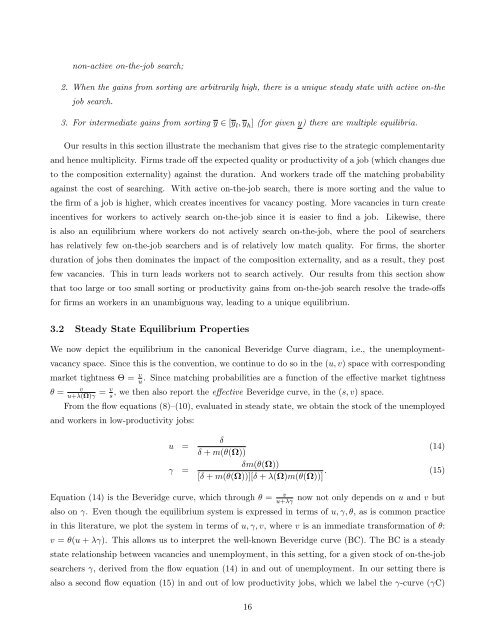Unemployment cycles
WP201526
WP201526
You also want an ePaper? Increase the reach of your titles
YUMPU automatically turns print PDFs into web optimized ePapers that Google loves.
non-active on-the-job search;<br />
2. When the gains from sorting are arbitrarily high, there is a unique steady state with active on-the<br />
job search.<br />
3. For intermediate gains from sorting y ∈ [y l , y h ] (for given y) there are multiple equilibria.<br />
Our results in this section illustrate the mechanism that gives rise to the strategic complementarity<br />
and hence multiplicity. Firms trade off the expected quality or productivity of a job (which changes due<br />
to the composition externality) against the duration. And workers trade off the matching probability<br />
against the cost of searching. With active on-the-job search, there is more sorting and the value to<br />
the firm of a job is higher, which creates incentives for vacancy posting. More vacancies in turn create<br />
incentives for workers to actively search on-the-job since it is easier to find a job. Likewise, there<br />
is also an equilibrium where workers do not actively search on-the-job, where the pool of searchers<br />
has relatively few on-the-job searchers and is of relatively low match quality. For firms, the shorter<br />
duration of jobs then dominates the impact of the composition externality, and as a result, they post<br />
few vacancies. This in turn leads workers not to search actively. Our results from this section show<br />
that too large or too small sorting or productivity gains from on-the-job search resolve the trade-offs<br />
for firms an workers in an unambiguous way, leading to a unique equilibrium.<br />
3.2 Steady State Equilibrium Properties<br />
We now depict the equilibrium in the canonical Beveridge Curve diagram, i.e., the unemploymentvacancy<br />
space. Since this is the convention, we continue to do so in the (u, v) space with corresponding<br />
market tightness Θ = v u<br />
. Since matching probabilities are a function of the effective market tightness<br />
v<br />
θ =<br />
u+λ(Ω)γ = v s<br />
, we then also report the effective Beveridge curve, in the (s, v) space.<br />
From the flow equations (8)–(10), evaluated in steady state, we obtain the stock of the unemployed<br />
and workers in low-productivity jobs:<br />
u =<br />
γ =<br />
δ<br />
δ + m(θ(Ω))<br />
(14)<br />
δm(θ(Ω))<br />
[δ + m(θ(Ω))][δ + λ(Ω)m(θ(Ω))] . (15)<br />
Equation (14) is the Beveridge curve, which through θ =<br />
v<br />
u+λγ<br />
now not only depends on u and v but<br />
also on γ. Even though the equilibrium system is expressed in terms of u, γ, θ, as is common practice<br />
in this literature, we plot the system in terms of u, γ, v, where v is an immediate transformation of θ:<br />
v = θ(u + λγ). This allows us to interpret the well-known Beveridge curve (BC). The BC is a steady<br />
state relationship between vacancies and unemployment, in this setting, for a given stock of on-the-job<br />
searchers γ, derived from the flow equation (14) in and out of unemployment. In our setting there is<br />
also a second flow equation (15) in and out of low productivity jobs, which we label the γ-curve (γC)<br />
16


